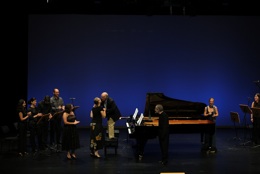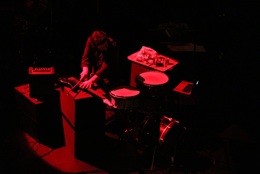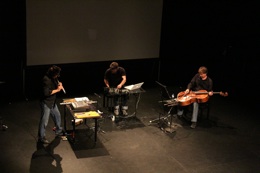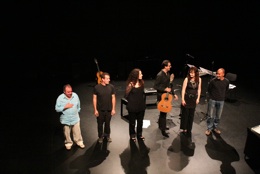| >> Versão Portuguesa |
|
| Three Nights at the CCB, between Homages and New Music TIAGO CABRITA |
2012.10.26 |
| The first three days of the Música Viva 2012 Festivalwere rich in the diversity of proposals and presented aesthetics, having pluralism as the motto. All of the days, without exception, had a remarkable attendance and the concert halls were practically full (the Small Auditorium – Eduardo Prado Coelho Hall and the Rehearsal Room of the Belém Arts Centre). It should be emphasized that the concert entitled “New Lyricism” was sold out, confirming the interest of the audience in New Portuguese Music, since four of the five composers, represented in the programme by a world-premiere piece, were native Portuguese or residing in Portugal. 1. The piano duo, with Elsa Marques Silva and Eugénia Chvetz, presented a quite inspirational communication between the two performers, in which one could identify dialogues, questions, responses and sound echoes. In the works of Álvaro Salazar, the ideas of time, space and the role of silence in music stand out. Actually, as the piece progresses, the sound objects appear and are subject to gradual evolutions, reappearing slightly modified. This creates a sensation of belonging to a common “space” between silence and sound. One belongs to the other. |
|
| Particularly in this piece, silence and space do play, in fact, an important role in the musical narrative, which is, in a certain way, “uncommunicative” – as the title indicates. Such a narrative is based on the apparent repetition of pointillist materials, which remain, in accordance with the composers’ criteria, resonating and echoing, always differently. In this sense, the two pianos, as they had identical timbres, were particularly efficient, since many times they functioned as each other’s echoes. The contribution of the pianists, who knew how to perform and transmit these ideas in a clear manner, achieving, throughout the performance of the work, an extremely interesting scale and variety of dynamics, from fortissimo to pppp, was very important.
The second piece, conducted by José Luís Borges Coelho with the participation of the Coral de Letras da Universidade do Porto and Inês Vicente as reciter, results form an expansion / renovation of the first one. Formally it is quite clear, interpolating the parts of the choir (with modest participation of the instruments) with moments in which pianos play the central role – in fact, one should stress the central part of considerable duration, preceding the final section. The choral parts, in which the text was mostly imperceptible considering the divergence between the (solo) voices, end up functioning as separators of the piano interventions. As mentioned, in this ambience, in which silence is confused with sound, music turns out to be unpredictable. This was precisely how the emotionally vibrant final section was: a poem was recited and together with the instrumental background one could discover – even though words do not enter this domain – the meaning of what one had heard before. 2. “Três Quadros sobre Pedra” (2008) by Luís Antunes Pena, combined the rhythmic elaboration/construction (almost implicit in percussion) with a diversity of timbres in a very balanced and interesting way. Each of the three pictures (or movements) presented an objective musical discourse, in which simplicity was revealed as a quality. Whereas, for example, the first picture was based on a dialogue between a continuum produced by the scraping of an object (varying throughout the movement) and the same type of sounds in the electronics, the second one was much more pulsated, with nerve, in an edgy performance by Nuno Aroso. Álvaro Salazar's, “Giuoco Piano” (2011) – world premiere performance – included a video of a chess game, played in gloves (one white, and the other one black), on a board surrounded by darkness. There was a common element with the pieces from the previous day: the incorporation of silence in musical discourse, with the use of diverse instruments, such as vibraphone, and other of undefined pitch standing out. The narrative of the piece was not obvious, like in “Estudos Incomunicantes”, and the video (which at a certain point was reversed) turned out to function not as a compliment (as I think would have been, perhaps, desirable), but rather as an autonomous element, which gained some primacy in relation to the musical narrative. On the other hand, the piece “Mán” (2011) by Virgílio Melo, presented as world-premiere, raised the expectations from the start through the visual component, given that there was (an attempt of) staging, in which the percussionist was on a totally dark stage, behind a folding screen (and therefore with no visual contact with him or his movements). The only light, which was visible precisely from behind the screen, reflected the movements of the steel drums. The electronics had the primary function of changing the timbre of the instrumental part through distortion. In spite of being very interesting from the sonorous and timbric point of view, “Mán”, for steel drums and electronics, revealed itself as too long. The piece (whose title signifies “Manna”) has undoubtedly a religious dimension and the discourse, of limited variation throughout the piece, transports us to a mystic experience. Nevertheless, the already mentioned absence of variety turned out to jeopardize the expectation created by the visual component. The piece by Pedro Junqueira Maia, “’xcuse me while I kiss the sky” (2010), was truly breathtaking and different from the previous proposals. Different, from the outset, for including an electric guitar part in homage to the guitar virtuoso Jimi Hendrix (the title comes from a verse from “Purple Haze”, one of Hendrix’s most emblematic songs). In fact, this “surprise” element (not in a piece with this title), revealed itself as such through how it was treated by the composer. The guitar had a percussive character throughout the piece and, even so, the instrument’s idiomatic language was audible, evoking Hendrix’s characteristic techniques, through the usage of “bending” together with a rather expansive distortion. The electronics came out quite well, using such techniques as granular synthesis, spatialization (panoramic), which was particularly efficient, and also a great sense of pulse, not only from the electric guitar, but also tom-toms, snare drum and bass drum. It would be difficult to end this programme in a better way. The second programme of the night, “Transversalities”, belonged to the OpenSPEECH ensemble, composed of Carlos Bechegas (flutes, voice, objects and electronics), Ulrich Mitzlaff (violoncello) and Carlos Santos (laptop and live-processing). All of the pieces performed by this ensemble had very interesting moments of interaction between the ensemble’s diverse components. One should stress the clarity of roles/functions the instruments (obviously, including the electronics) presented throughout the improvisations based on graphic scores. Bechegas seemed to be the most noticeable element in the ensemble, not only for resorting to more instruments, but also due to the variety of techniques he used (from vocal sounds, to the Aeolian sound of the flute(s) or a mixture between blowing and defined pitch). Therefore, he transmitted visual and auditive pleasure for the enthusiasm and dedication he presented during this concert. One should also emphasize a moment of sublime improvisation by Urlich Mitzlaff, finishing one of the pieces, as well as the discrete (but, even so, not less important) participation of Carlos Santos. At times, discretion is an enormous quality and that was certainly the case. Nevertheless, and despite the good formal construction of the improvisations, there seemed to exist a certain lack of consequence and connection between the elements, which were included in the musical discourse, perhaps due to what by definition is the somewhat unpredictable result of improvisation (even when it is controlled by graphics). 3. From José Luís Ferreira's piece, “L’Histoire d’amour entre” (2012) for flute, guitar and live electronics, one should highlight, from the outset, the immense space and environment created by reverberation in the initial section (very well programmed), giving great expressivity to the sound. The dynamics between the guitar, flute and electronics (accelerating and recoiling velocity of the echoes/accords created in response to the instruments) resulted extremely well. The second section of the piece ranged spaces and dynamics, letting the melody come to the first plan, being also marked by an enormous expressivity and lyricism. With a tempo faster than the first section, the composer chose to give the piece a sense of pulsation and also to create a counterpoint contrasting with the first one, of a more vertical discourse (or, at least, with a more pronounced feeling of harmonies being created in the electronics). In Evgueny Zoudilkine's, “Aguarela III” (2012), one should acknowledge the expressivity achieved through a very interesting sense of movement and melody, in which the sound, although sharp (due to the usage of dissonances), turns out to be extremely involving and sensible. The Italian composer Massimo Davi wrote for flute and guitar the piece “4 Canzoni di Flora” (2011), a group of four movements, whose common characteristics were the varied and efficient exploration of instrumental timbres of the Ensemble. The discourse seemed to deal with the development of only one idea in each movement, what could have had a better result if there had been a major contrast between the four pieces. Nevertheless, the second and fourth movements, in which the guitar ends up having more preponderance in the music, were particularly rich. In the second one, for example, a bottleneck (a metal tube used for slide guitar technique) is used, altering the guitar’s timbre in a significant way. The flute uses another special technique, whistle sounds, combining two distinctly different timbres, which are quite conventional on these instruments, in an interesting way. The fourth movement, on the other hand, with more movement and velocity than the three previous ones, resorts to an object, which imprisons/”suffocates” some guitar strings, so that they loosen their force to vibrate, producing, as a result, a particularly dry sound. It is, therefore, the piece, which emanates through the contrast, not present in the three previous ones. “SAH” (2012), for flute, guitar and electronics, by Carlos Caires, was absolutely sublime. In the piece’s first section, one should emphasize the excellent integration of electronics in the instrumental effect that has become a distinctive mark of Carlos Caires’ work. Indeed, I dare say, the inclusion of electronics is in the instrumental plan, as well as the (micro)montage of sound. The piece’s second section, in turn, establishes a very interesting dynamics between the ensemble and electronics. Contrasting with the first one, it has a more rhythmical character and it thus creates high expectations in the listener (caused by the unpredictability of the discourse, very well constructed and coherent). Throughout the piece, there are quite diversified and contrasting moments, such as, for example the third section, which is more static than the two previous ones. The last minutes of the piece were notable, and in fact truly extraordinary concerning the construction of the electronics’ sound and cutting. Perta Bachratá wrote “Machina Lirica” in 2012, for flute and guitar. The piece, with a sharp and steely sonority, is quite rich in the variety of means and composing for every instrument, particularly the flute. Monika Streitová was extremely competent in the piece, which seemed to be of difficult technical execution. An extraordinary concert, not only for the quality of the works presented, but also because it is a privilege to be able to listen to performances with the quality – excellent in any part the world – of Pedro Rodrigues and Monika Streitová. The night’s second programme, “Improvisation”, was truly unexpected. The trio, composed of Ernesto Rodrigues (viola), Radu Malfatti (trombone) and Ricardo Guerreiro (computer), performed an improvisation based on the sounds of silence. At the concert, in which the visual component complemented and strengthened the auditive one – both of them extremely static, with the performers practically motionless from the beginning to the end of improvisation and an extremely slow evolution of every musical gesture – there was a complete absence of linear time. One lost track of what was the beginning, middle or end, seemingly creating a new concept of time – slow, ceased in itself, almost as an instant that repeats itself and changes. Between the sounds of breathing, the aeolian sound of the trombone, the minimalistic interventions of the electronics and the tremolos of the viola in pppp and at extremely high pitches, the musicians created an atmosphere of “mute” dialogue between the ensemble, the space and the public, in which everything – even the silence – transformed itself in the trio’s improvisation. |
|

 Nuno Aroso
Nuno Aroso OpenSPEECH Trio
OpenSPEECH Trio Machina Lirica Ensemble
Machina Lirica Ensemble